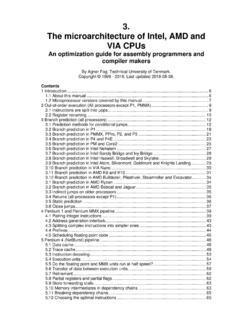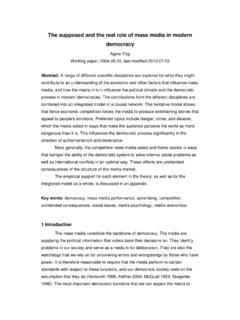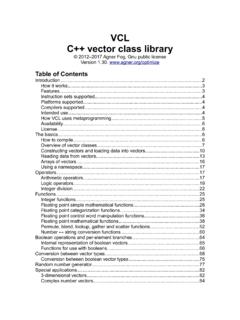Transcription of 4. Instruction tables - agner.org
1 IntroductionPage 14. Instruction tablesBy Agner Fog. Technical University of 1996 2017. Last updated This is the fourth in a series of five manuals:2. Optimizing subroutines in assembly language: An optimization guide for x86 platforms. 5. Calling conventions for different C++ compilers and operating notice Lists of Instruction latencies, throughputs and micro-operation breakdowns for Intel, AMD and VIA CPUs1. Optimizing software in C++: An optimization guide for Windows, Linux and Mac The microarchitecture of Intel, AMD and VIA CPUs: An optimization guide for assembly programmers and compiler makers. 4. Instruction tables : Lists of Instruction latencies, throughputs and micro-operation breakdowns for Intel, AMD and VIA CPUs. The latest versions of these manuals are always available from conditions are listed present manual contains tables of Instruction latencies, throughputs and micro-operation breakdown and other tables for x86 family microprocessors from Intel, AMD and figures in the Instruction tables represent the results of my measurements rather than the offi-cial values published by microprocessor vendors.
2 Some values in my tables are higher or lower than the values published elsewhere. The discrepancies can be explained by the following factors: My figures are experimental values while figures published by microprocessor vendors may be based on theory or simulations. My figures are obtained with a particular test method under particular conditions. It is possible that different values can be obtained under other conditions. Some latencies are difficult or impossible to measure accurately, especially for memory access and type conversions that cannot be chained. Latencies for moving data from one execution unit to another are listed explicitly in some of my tables while they are included in the general latencies in some tables published by values are the same in all microprocessor modes (real, virtual, protected, 16-bit, 32-bit, 64-bit). Values for far calls and interrupts may be different in different modes.
3 Call gates have not been with a LOCK prefix have a long latency that depends on cache organization and possi-bly RAM speed. If there are multiple processors or cores or direct memory access (DMA) devices then all locked instructions will lock a cache line for exclusive access, which may involve RAM ac-cess. A LOCK prefix typically costs more than a hundred clock cycles, even on single-processor systems. This also applies to the XCHG Instruction with a memory any text in the pdf version of this manual is unreadable, then please refer to the spreadsheet 2 This series of five manuals is copyrighted by Agner Fog. Public distribution and mirroring is not allowed. Non-public distribution to a limited audience for educational purposes is allowed. The code examples in these manuals can be used without restrictions. A GNU Free Documentation License shall automatically come into force when I die.
4 See of termsPage 3 Definition of termsInstructionOperandsLatencyThe Instruction name is the assembly code for the Instruction . Multiple instructions or multiple variants of the same Instruction may be joined into the same line. Instructions with and without a 'v' prefix to the name have the same values unless otherwise can be different types of registers, memory, or immediate constants. Ab-breviations used in the tables are: i = immediate constant, r = any general purpose register, r32 = 32-bit register, etc., mm = 64 bit mmx register, x or xmm = 128 bit xmm register, y = 256 bit ymm register, z = 512 bit zmm register, v = any vector register, sr = segment register, m = any memory operand including indirect operands, m64 means 64-bit memory operand, latency of an Instruction is the delay that the Instruction generates in a depen-dency chain. The measurement unit is clock cycles.
5 Where the clock frequency is var-ied dynamically, the figures refer to the core clock frequency. The numbers listed are minimum values. Cache misses, misalignment, and exceptions may increase the clock counts considerably. Floating point operands are presumed to be normal num-bers. Denormal numbers, NAN's and infinity may increase the latencies by possibly more than 100 clock cycles on many processors, except in move, shuffle and Boolean instructions. Floating point overflow, underflow, denormal or NAN results may give a similar delay. A missing value in the table means that the value has not been mea-sured or that it cannot be measured in a meaningful processors have a pipelined execution unit that is smaller than the largest regis-ter size so that different parts of the operand are calculated at different times. As-sume, for example, that we have a long depencency chain of 128-bit vector instruc-tions running in a fully pipelined 64-bit execution unit with a latency of 4.
6 The lower 64 bits of each operation will be calculated at times 0, 4, 8, 12, 16, etc. And the upper 64 bits of each operation will be calculated at times 1, 5, 9, 13, 17, etc. as shown in the figure below. If we look at one 128-bit Instruction in isolation, the latency will be 5. But if we look at a long chain of 128-bit instructions, the total latency will be 4 clock cycles per Instruction plus one extra clock cycle in the end. The latency in this case is listed as 4 in the tables because this is the value it adds to a dependency throughputThe throughput is the maximum number of instructions of the same kind that can be executed per clock cycle when the operands of each Instruction are independent of the preceding instructions. The values listed are the reciprocals of the throughputs, the average number of clock cycles per Instruction when the instructions are not part of a limiting dependency chain.
7 For example, a reciprocal throughput of 2 for FMUL means that a new FMUL Instruction can start executing 2 clock cycles after a previous FMUL. A reciprocal throughput of for ADD means that the execution units can handle 3 integer additions per clock reason for listing the reciprocal values is that this makes comparisons between la-tency and throughput easier. The reciprocal throughput is also called issue of termsPage 4 opsHow the values were measuredThe values listed are for a single thread or a single core. A missing value in the table means that the value has not been or op is an abbreviation for micro-operation. Processors with out-of-order cores are capable of splitting complex instructions into ops. For example, a read-modify in-struction may be split into a read- op and a modify- op. The number of ops that an Instruction generates is important when certain bottlenecks in the pipeline limit the number of ops per clock unitThe execution core of a microprocessor has several execution units.
8 Each execution unit can handle a particular category of ops, for example floating point additions. The information about which execution unit a particular op goes to can be useful for two purposes. Firstly, two ops cannot execute simultaneously if they need the same exe-cution unit. And secondly, some processors have a latency of an extra clock cycle when the result of a op executing in one execution unit is needed as input for a op in another execution portThe execution units are clustered around a few execution ports on most Intel proces-sors. Each op passes through an execution port to get to the right execution unit. An execution port can be a bottleneck because it can handle only one op at a time. Two ops cannot execute simultaneously if they need the same execution port, even if they are going to different execution setThis indicates which Instruction set an Instruction belongs to.
9 The Instruction is only available in processors that support this Instruction set. The different Instruction sets are listed at the end of this manual. Availability in processors prior to 80386 does not apply for 32-bit and 64-bit operands. Availability in the MMX Instruction set does not apply to 128-bit packed integer instructions, which require SSE2. Availability in the SSE Instruction set does not apply to double precision floating point instructions, which require instructions are available in 80386 and later. 64-bit instructions in general pur-pose registers are available only under 64-bit operating systems. Instructions that use XMM registers (SSE and later) are only available under operating systems that sup-port this register set. Instructions that use YMM registers (AVX and later) are only available under operating systems that support this register values in the tables are measured with the use of my own test programs, which are available from The time unit for all measurements is CPU clock cycles.
10 It is attempted to obtain the highest clock frequency if the clock frequency is varying with the workload. Many Intel processors have a perfor-mance counter named "core clock cycles". This counter gives measurements that are independent of the varying clock frequency. Where no "core clock cycles" counter is available, the "time stamp counter" is used (RDTSC Instruction ). In cases where this gives inconsistent results ( in AMD Bobcat) it is necessary to make the processor boost the clock frequency by executing a large num-ber of instructions (> 1 million) or turn off the power-saving feature in the BIOS throughputs are measured with a long sequence of instructions of the same kind, where subsequent instructions use different registers in order to avoid dependence of each Instruction on the previous one. The input registers are cleared in the cases where it is impossible to use different registers.







